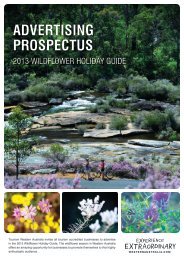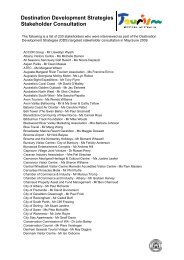A Strategic Approach to the Caravan and Camping Industry 2012
A Strategic Approach to the Caravan and Camping Industry 2012
A Strategic Approach to the Caravan and Camping Industry 2012
Create successful ePaper yourself
Turn your PDF publications into a flip-book with our unique Google optimized e-Paper software.
CURRENT PROFILE OF THE CARAVAN PARK INDUSTRY<br />
Status of <strong>the</strong> <strong>Caravan</strong> <strong>and</strong> <strong>Camping</strong> <strong>Industry</strong> Sec<strong>to</strong>r<br />
Australia<br />
Tourism Research Australia’s National <strong>and</strong> International Visi<strong>to</strong>r Surveys estimate 8.2<br />
million domestic visi<strong>to</strong>rs (40.9 million nights) <strong>and</strong> 321,400 international visi<strong>to</strong>rs (4.5<br />
million nights) stayed overnight in caravan or camping accommodation across<br />
Australia in 2009. There has been virtually no annual change or fluctuations over <strong>the</strong><br />
last 10 years in spite of <strong>to</strong>tal domestic visitation dropping 6 percent over <strong>the</strong> same<br />
period. Whilst <strong>the</strong> number of international visi<strong>to</strong>rs has grown by around one percent<br />
for <strong>the</strong> last 10 years, <strong>the</strong> number of international visi<strong>to</strong>r nights has declined by one<br />
percent (average annual change). This indicates more international caravan <strong>and</strong><br />
camping visi<strong>to</strong>rs are coming <strong>to</strong> Western Australia, though staying for shorter<br />
durations. 8<br />
<strong>Caravan</strong> <strong>and</strong> camping accommodation accounted for 16 percent of <strong>to</strong>tal domestic<br />
nights <strong>and</strong> 12 percent of <strong>to</strong>tal domestic visi<strong>to</strong>rs in 2009. Domestic caravan <strong>and</strong><br />
camping visi<strong>to</strong>rs spent an average of $117 per night <strong>and</strong> international visi<strong>to</strong>rs spent<br />
$115 per night, compared <strong>to</strong> o<strong>the</strong>r domestic <strong>and</strong> international visi<strong>to</strong>rs who spend<br />
$176 <strong>and</strong> $253 per night respectively. 9<br />
According <strong>to</strong> IBIS World, “<strong>the</strong> industry is largely sensitive <strong>to</strong> trends in domestic<br />
overnight travel <strong>and</strong> international visi<strong>to</strong>r arrivals. Overall dem<strong>and</strong> originating from<br />
<strong>the</strong>se groups is driven by growth in household disposable income <strong>and</strong> <strong>the</strong> frequency<br />
<strong>and</strong> length of holidays taken. The continuing escalation in overseas travel by<br />
Australians due <strong>to</strong> <strong>the</strong> strong exchange rate is also dampening domestic travel<br />
dem<strong>and</strong>.<br />
The industry is estimated <strong>to</strong> generate $1.31 billion in revenue during 2011-12, up 1.1%<br />
for <strong>the</strong> year due <strong>to</strong> steady dem<strong>and</strong> from domestic <strong>and</strong> international <strong>to</strong>urism. This<br />
growth also contributes <strong>to</strong> an estimated average annual growth rate of 1.3% for <strong>the</strong><br />
five years through 2011-12. The industry is forecast <strong>to</strong> comprise about 1,435 longterm<br />
<strong>and</strong> short-term stay enterprises, down 0.2% from <strong>the</strong> previous year, largely due<br />
<strong>to</strong> <strong>the</strong> closure of caravan parks as property values increased <strong>and</strong> owners sold assets.<br />
<strong>Industry</strong> employment is expected <strong>to</strong> increase by 0.7% <strong>to</strong> around 10,650 workers in<br />
2011-12.<br />
Over <strong>the</strong> next five years through 2016-17, <strong>to</strong>tal industry revenue is expected <strong>to</strong><br />
increase by 1% per annum <strong>to</strong> around $1.38 billion. Site numbers <strong>and</strong> site capacity<br />
levels are expected <strong>to</strong> continue <strong>to</strong> decline at a slow, steady rate in future years.<br />
Domestic visi<strong>to</strong>r numbers are anticipated <strong>to</strong> remain relatively stable, while<br />
international visi<strong>to</strong>r numbers will decline due <strong>to</strong> <strong>the</strong> high Australian dollar.” 10<br />
IBIS World reported that caravan parks <strong>and</strong> campgrounds wea<strong>the</strong>red <strong>the</strong> recent<br />
economic downturn better than most o<strong>the</strong>rs in <strong>the</strong> wider accommodation sec<strong>to</strong>r due<br />
<strong>to</strong> a combination of lower pricing, growth in site tariffs <strong>and</strong> increased dem<strong>and</strong> for<br />
better-quality facilities, such as cabins, which comm<strong>and</strong> higher rates.<br />
IBIS World noted that “in 2006-07 <strong>and</strong> 2007-08, higher fuel prices directly affected<br />
domestic travel patterns <strong>and</strong> cheap domestic airfares led <strong>to</strong> a rise in interstate travel<br />
<strong>and</strong> less use of mo<strong>to</strong>r vehicles for <strong>to</strong>wing caravans. Fur<strong>the</strong>rmore, Australians travelling<br />
overseas <strong>and</strong> interstate travellers were more likely <strong>to</strong> take advantage of combined<br />
cheap airfare <strong>and</strong> accommodation packages at hotels <strong>and</strong> resorts, ra<strong>the</strong>r than staying<br />
at caravan parks. For 2007-08, <strong>to</strong>tal caravan park establishments fell by 0.8% <strong>and</strong> <strong>to</strong>tal<br />
site capacity by 0.2% <strong>to</strong> 233,500. Site nights occupied rose 1.8% <strong>to</strong> 45.1 million as <strong>the</strong><br />
average site occupancy rate increased only marginally <strong>to</strong> 53%.” 11<br />
<strong>Industry</strong> outlook<br />
IBIS World predicts that “future industry revenue levels are expected <strong>to</strong> rise due <strong>to</strong><br />
<strong>the</strong> continuing availability <strong>and</strong> popularity of better quality on-site cabins <strong>and</strong> units at<br />
higher nightly tariffs. Some caravan park owners are expected <strong>to</strong> take advantage of<br />
high l<strong>and</strong> prices <strong>and</strong> sell <strong>the</strong>ir properties. This will result in both decreases in actual<br />
site capacity <strong>and</strong> increases in occupancy rates in existing caravan parks.<br />
Less seasonal patterns of use compared with powered <strong>and</strong> unpowered sites <strong>and</strong> an<br />
increasing use of RVs by <strong>to</strong>urists on extended holiday trips will also aid growth for<br />
industry opera<strong>to</strong>rs over <strong>the</strong> next five years. Use of long-term caravan park sites will<br />
spike fur<strong>the</strong>r, due <strong>to</strong> ongoing reduced affordability of residential housing, for ei<strong>the</strong>r<br />
purchase or rental. A fur<strong>the</strong>r rise in profit margins is anticipated from industry<br />
8 <strong>Caravan</strong> or <strong>Camping</strong> in Australia Snapshots 2009 Tourism Research Australia. 2010<br />
9 <strong>Caravan</strong> or <strong>Camping</strong> in Australia Snapshots 2009 Tourism Research Australia. 2010<br />
10 IBIS World <strong>Caravan</strong> Parks <strong>and</strong> Campgrounds in Australia July 2011<br />
11 IBIS World <strong>Caravan</strong> Parks <strong>and</strong> Campgrounds in Australia July 2011<br />
A <strong>Strategic</strong> <strong>Approach</strong> <strong>to</strong> <strong>Caravan</strong> <strong>and</strong> <strong>Camping</strong> Tourism in Western Australia Page 8




![Annual Report 2002 - 2003 [pdf ] - Tourism Western Australia](https://img.yumpu.com/27124309/1/186x260/annual-report-2002-2003-pdf-tourism-western-australia.jpg?quality=85)
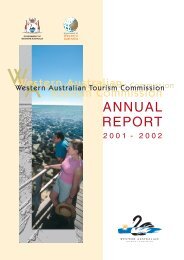

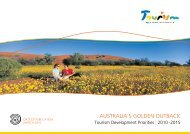

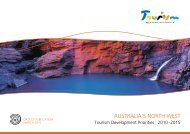

![Our Direction in China 2012 - 2015 [pdf ] - Tourism Western Australia](https://img.yumpu.com/27124271/1/184x260/our-direction-in-china-2012-2015-pdf-tourism-western-australia.jpg?quality=85)
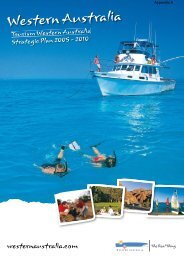

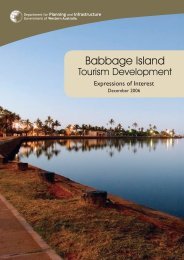
![Naturebank Program 2011 [pdf ] - Tourism Western Australia](https://img.yumpu.com/27124244/1/184x260/naturebank-program-2011-pdf-tourism-western-australia.jpg?quality=85)
